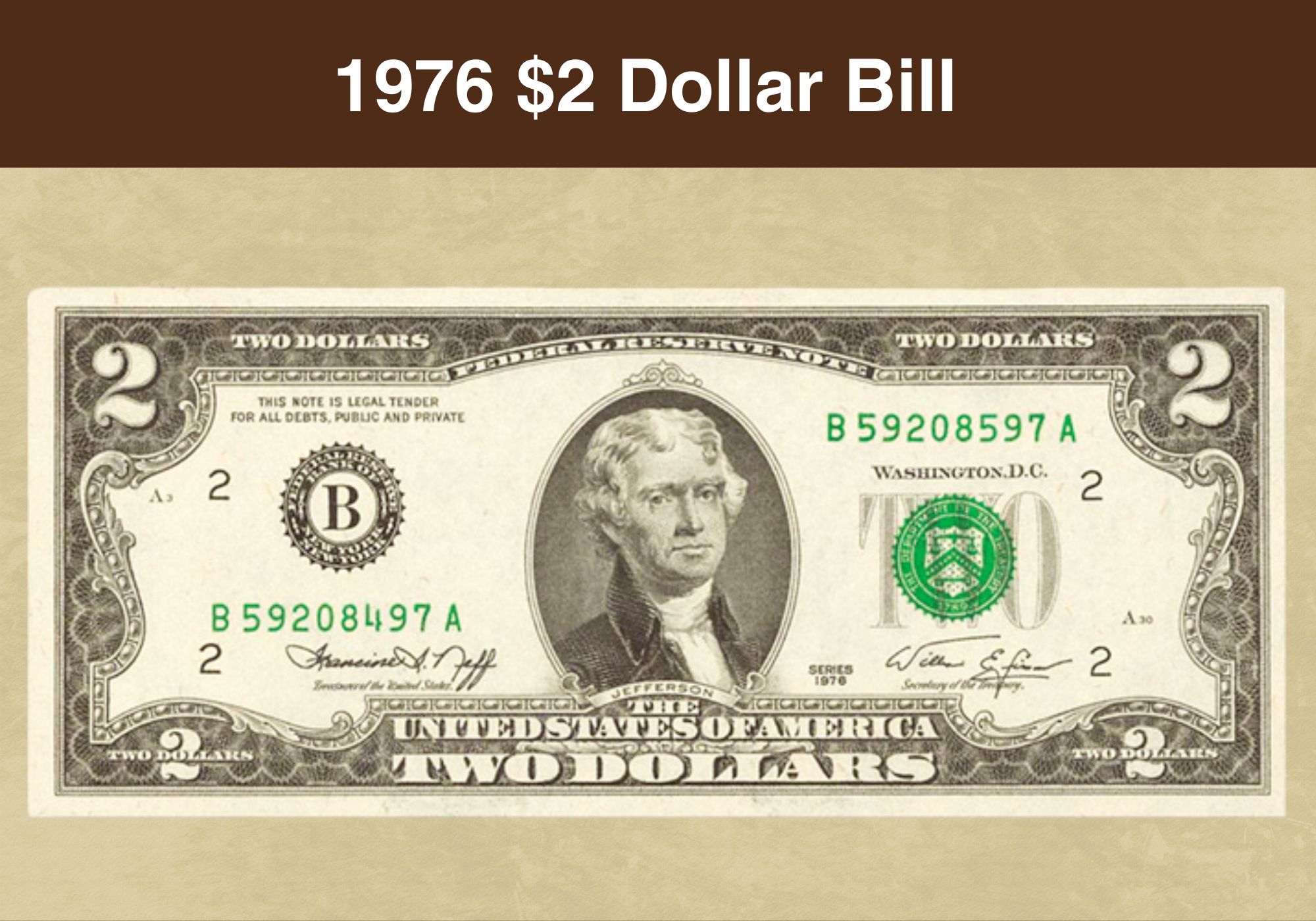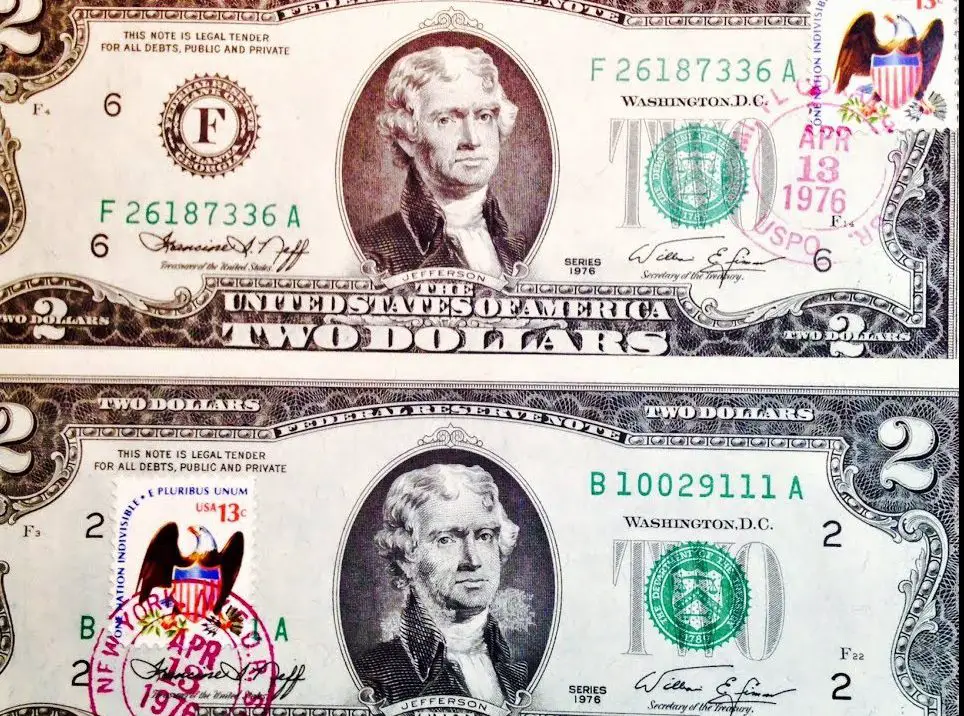The 1976 $2 bill is a fascinating piece of American currency that holds both historical and monetary value. Issued as part of the United States' bicentennial celebration, this bill has captured the interest of collectors and enthusiasts alike. Understanding its value involves delving into its history, rarity, and current market demand.
This article will provide an in-depth exploration of the 1976 $2 bill value, covering everything from its historical background to factors that influence its worth. Whether you're a collector, an investor, or simply curious about this iconic piece of currency, this guide will equip you with the knowledge you need.
Join us as we uncover the story behind the 1976 $2 bill and why it continues to captivate numismatists worldwide. From its minting process to its current market trends, we'll explore all aspects that contribute to its value.
Read also:Joey Drea De Matteo A Rising Star In The Entertainment Industry
Table of Contents
- History of the 1976 $2 Bill
- Minting Process and Design
- Factors Affecting the Value of the 1976 $2 Bill
- Rarity and Condition
- Market Demand and Trends
- Collector's Guide to 1976 $2 Bills
- Investment Potential
- How to Authenticate a 1976 $2 Bill
- Tips for Preserving Your 1976 $2 Bill
- Frequently Asked Questions
History of the 1976 $2 Bill
The 1976 $2 bill was introduced as part of the United States' bicentennial celebration, marking 200 years since the Declaration of Independence. This bill was the first time the $2 denomination was reissued since 1966, making it a significant moment in American currency history.
Why Was the 1976 $2 Bill Issued?
The primary purpose of issuing the 1976 $2 bill was to commemorate the bicentennial. The bill featured Thomas Jefferson on the front and the iconic painting "The Signing of the Declaration of Independence" on the back, symbolizing the nation's founding principles.
Historical Significance
Although the $2 bill was first introduced in 1862, its discontinuation in 1966 led many to believe it was permanently retired. The 1976 reissue revived interest in this denomination, making it a collector's item due to its limited circulation.
Minting Process and Design
The minting process of the 1976 $2 bill involved advanced techniques for its time, ensuring high-quality production. The design elements were carefully chosen to reflect the historical significance of the bicentennial year.
Design Features
- Front: Portrait of Thomas Jefferson
- Back: John Trumbull's painting "The Signing of the Declaration of Independence"
- Serial Numbers: Unique identifiers for each bill
Security Features
While modern security features were not as advanced in 1976, the bill included watermarks and unique paper composition to prevent counterfeiting.
Factors Affecting the Value of the 1976 $2 Bill
Several factors contribute to the value of a 1976 $2 bill. Understanding these elements is crucial for collectors and investors alike.
Read also:Who Is Jean Garcias Husband A Comprehensive Look Into Her Personal Life
Rarity
The rarity of a 1976 $2 bill depends on its serial number, mint mark, and condition. Bills with unique serial numbers, such as those starting with "A1" or "B1," are often more valuable.
Condition
The physical condition of the bill plays a significant role in determining its value. Uncirculated bills in pristine condition can fetch higher prices compared to worn or damaged ones.
Market Demand
Current market trends and collector interest also influence the value of the 1976 $2 bill. Bills with unique features or historical significance tend to attract higher demand.
Rarity and Condition
Rarity and condition are two critical factors that determine the worth of a 1976 $2 bill. Collectors often seek bills with unique characteristics, such as low serial numbers or error notes.
Unique Serial Numbers
Bills with serial numbers like "A1" or "B1" are highly sought after due to their rarity. These numbers indicate the first batch of bills printed in a particular series, making them more valuable.
Error Notes
Error notes, such as misprints or alignment issues, are rare and can significantly increase the value of a 1976 $2 bill. Collectors often pay a premium for these unique pieces.
Market Demand and Trends
The market demand for 1976 $2 bills fluctuates based on collector interest and economic trends. Understanding these dynamics can help you make informed decisions about buying or selling.
Collector Interest
Interest in the 1976 $2 bill has grown over the years, particularly among numismatists who appreciate its historical significance. This increased interest has driven up prices for rare and unique bills.
Economic Trends
Economic factors, such as inflation and currency values, can also impact the market for collectible currency. Staying informed about these trends can help you capitalize on opportunities.
Collector's Guide to 1976 $2 Bills
For collectors, understanding the nuances of the 1976 $2 bill market is essential. This guide provides tips and insights for building a valuable collection.
Building a Collection
Start by focusing on bills with unique features, such as low serial numbers or error notes. Attend auctions and connect with fellow collectors to discover rare pieces.
Grading and Certification
Invest in grading and certification services to ensure the authenticity and condition of your bills. Reputable organizations like PCGS and NGC provide expert evaluations.
Investment Potential
The 1976 $2 bill offers potential as an investment opportunity, particularly for those interested in collectible currency. However, it's important to approach this market with caution.
Risk and Reward
While the potential for profit exists, the collectible currency market can be unpredictable. Conduct thorough research and consult experts before making significant investments.
Diversification
Consider diversifying your investment portfolio by including a mix of rare coins and bills. This approach can help mitigate risks and maximize returns.
How to Authenticate a 1976 $2 Bill
Authenticating a 1976 $2 bill is crucial to ensure its value and protect against counterfeits. Follow these steps to verify its legitimacy.
Examine the Serial Number
Check the serial number for consistency and alignment. Authentic bills will have evenly spaced numbers with no signs of tampering.
Inspect the Paper and Ink
Authentic bills are printed on specialized paper with unique ink properties. Look for watermarks and other security features to confirm authenticity.
Tips for Preserving Your 1976 $2 Bill
Proper care and storage are essential for maintaining the value of your 1976 $2 bill. Follow these tips to ensure its longevity.
Storage Solutions
Store your bills in acid-free sleeves or albums to protect them from environmental damage. Avoid exposing them to direct sunlight or extreme temperatures.
Handling Guidelines
Handle your bills with clean, dry hands to prevent oils and dirt from damaging the surface. Use gloves if necessary to maintain their condition.
Frequently Asked Questions
What Is the Current Value of a 1976 $2 Bill?
The value of a 1976 $2 bill varies based on its condition, rarity, and market demand. On average, uncirculated bills can range from $5 to $20, while rare or error notes may fetch significantly higher prices.
How Can I Sell My 1976 $2 Bill?
Selling your 1976 $2 bill can be done through online marketplaces, auctions, or private collectors. Ensure the bill is authenticated and graded before listing it for sale.
Are All 1976 $2 Bills Collectible?
While all 1976 $2 bills have historical significance, not all are considered collectible. Bills with unique features, such as low serial numbers or error notes, are typically more valuable.
Conclusion
The 1976 $2 bill is a fascinating piece of American currency that holds both historical and monetary value. From its bicentennial origins to its current market trends, this bill continues to captivate collectors and enthusiasts worldwide.
We encourage you to explore the world of numismatics and discover the treasures that await. Share your thoughts and experiences in the comments below, and don't forget to check out our other articles for more insights into collectible currency.
References:
- U.S. Bureau of Engraving and Printing
- Professional Coin Grading Service (PCGS)
- National Coin Certification (NGC)


